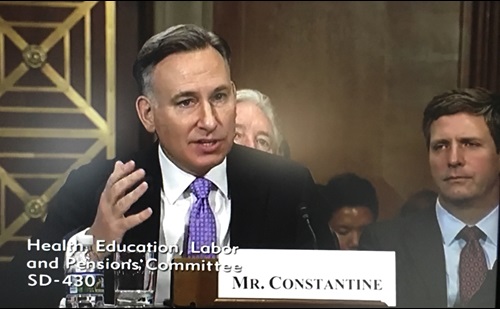King County Executive Dow Constantine testified before U.S. Senate Committee
Wednesday, November 28, 2018
King County Executive Dow Constantine testified before the full U.S. Senate Committee on Health, Education, Labor and Pensions, chaired by Sen. Lamar Alexander, R-Tenn. Sen. Patty Murray, D-Wash., who serves as Ranking Member of the committee, invited Executive Constantine to the hearing.
Executive Constantine described the success and challenges of moving toward a more affordable, high quality, and prevention-oriented health system before a U.S. Senate Health, Education, Labor and Pensions committee hearing, “Reducing Health Care Costs: Improved Affordability Through Innovation.”
Video of Executive Constantine’s testimony can be viewed here.
Here are Executive Constantine’s remarks:
Chairman Alexander, Ranking Member Murray, and members of the Committee, thank you for the opportunity to speak to you today.
I am Dow Constantine, the elected Executive of Martin Luther King, Jr. County, in Seattle, Washington. King County delivers vital regional governmental services including…
─ housing,
─ transit,
─ criminal justice, and…
─ public health for nearly 2.2 million people.
King County reduced health care costs and also worked upstream to prevent those costs in the first place, through our work as the public health provider and our early childhood initiative, Best Starts for Kids.
My written testimony provides more detail of our unique vantage point as both a purchaser of health care for our 15,000 workers, and a provider of public health services.
Our story illustrates that to succeed in moving toward a more affordable, high quality, and prevention-oriented health system, you need partnerships…
─ between patients and providers,
─ between management and employees,
─ between employers and health plan administrators, and…
─ between the public health system and the health care delivery systems.
Managing the rising costs of employee health care is an ongoing challenge. Today, King County spends over $235 million each year.
In the early part of this century, as employers around the nation faced skyrocketing health care costs, King County
responded with two key actions:
First, we convened our region’s purchasers, health plans, and providers to jointly tackle cost and quality problems. We founded what it is now known as the Washington Health Alliance, whose vital work to increase transparency you heard about in this committee last month.
Second, we approached our labor partners, with whom we negotiate benefits. Together, we designed a high-quality, lower-cost health plan with a local HMO that is about one third cheaper than our traditional plan.
We also put in place a wellness initiative called Healthy Incentives, where participating employees enjoyed lower out-of-pocket costs.
Over a five year period, we saved about $46 million; and our approach earned us the 2013 Harvard Innovations in Government award.
That alone was not good enough.
By tracking the data, we realized savings from this approach had plateaued.
So we sharpened our focus on achieving value instead of volume, building off lessons learned from private sector leaders like Boeing.
This year we added a new value-based plan choice for employees – accountable health networks. Enrollment in value-based plans has grown from 21 percent of our employees in 2011, to 37 percent today. We are now working to double enrollment in the next five years.
King County also overhauled our wellness program this year, disconnecting participation from what employees pay for their coverage.
Our new approach focuses on building an overall culture of health, going beyond the typical calls to exercise more and eat better. Most important, we’ve taken a public health approach to employee healthcare by tailoring efforts to our diverse workforce.
An example of our more tailored approach is with our 4,000-plus transit employees. As it turns out, compared to other County workers, this group was much less likely to have had a recent dental check-up – nearly 1 out of 3 had not visited a dentist in the past year.
So we worked with the transit union and our dental carrier to design a six-month pilot in which we are reducing cost sharing, going to bus bases to offer scheduling help, and taking other steps to help our workers find a dentist that’s right for them. This will help avoid not just cavities but future costs for both us and our employees.
As we look ahead, I’d like to highlight three areas where Congress’ attention would help foster continued innovation to manage health care costs:
- First, the federal government should continue to use its significant purchasing power to accelerate strategies that pay for value over volume, increase transparency, and help all payers better align their efforts – focusing on the pharmaceutical industry in particular.
- Second, I urge you to increase investments in prevention in both public health and behavioral health. Benjamin Franklin was right when he said it represented the best value proposition.
- Finally, we ask that you work to protect the gains in coverage, care, and prevention of the ACA. Over time, access to a healthier workforce can help employers like King County and others across the region better fulfill their missions and strengthen our competitive edge.
Thank you and I look forward to your questions.





0 comments:
Post a Comment